Review and photos by Patryx
Tyrannosaurus, Triceratops, Velociraptor, Mosasaurus, and Pteranodon. What a familiar lineup! This is a set decidedly influenced by the hype surrounding the latest installment in the Jurassic Park franchise, consisting of five iconic creatures from all over the Cretaceous. It’s an intriguing concept, as Kaiyodo is revered for their up-to-date reconstructions, and Jurassic Park is, well, not. Not anymore, at least. So, have Kaiyodo finally snapped and made a whole set of unlicensed movie monsters? Let’s find out together!
Firstly, we have that most popular of pterosaurs, Pteranodon longiceps. It’s meant to represent a male, by the look of the skull. Mounted on a transparent rod affixed to a stone-shaped base, the animal is posed in flight, with his head pointed downward. The wings are reaching up – flapping, not gliding. In a realistic touch, the hips and legs are angled downward. This makes a counter-balanced pose that is part of the flight-cycle of today’s birds and bats – and presumably, yesterday’s pterosaurs. The colors are excellent, a mix of subtle blends and sharp patterns, with a splash of red for the crest.
Ah, but what about accuracy? At a glance, he looks quite promising. All the major boxes are checked. The beak features its characteristic upward bend, the feet are appropriately small, and the patagia (wing membranes) are correctly attached and shaped. Close inspection reveals the inclusion of the dense coat of pycnofibres, adding dimension to the head, neck, and chest. There’s also a nice, fibrous texture to the wings, illustrating their underlying complexity. In short, Kaiyodo do not disappoint in this case. This is no movie monster!
Next up is the colossal aquatic squamate, Mosasaurus hoffmanni. This big lug certainly makes an impression. Its sinuous, serpentine posture takes up a lot of space, and its gaping maw makes it look just a little like it belongs on the cover of a rock album. Like with the Pteranodon, support is provided in the form of a rocky base – this time with a tiny ammonite sculpted into it. The coloration is a little simpler here, with gradual counter-shading from a forest-green to pale yellow. Boxy rosettes in dark purple adorn the flanks, and the eyes gleam orange. The inside of the mouth is a convincing salmon tone, except the tongue, which shares its purple with the aforementioned body markings.
In terms of accuracy, this one comes rather closer to its big-screen counterpart, with warty, pebbly skin and a lean form. Modern reconstructions of mosasaurs tend to convey something a little more convergent with modern whales – streamlined and torpedo-like. However, despite being a little old-fashioned, this figure seems pretty plausible. Some important elements are here: the tail fluke, and the broad flippers. Additionally, the tongue is bifurcated; an excellent detail that belies the animal’s connection to other squamates. Inexplicably, however, the palatine teeth seem to be missing completely! Looking closely, one could suspect that they were sculpted, but left unpainted. After all, ignoring such an important detail is almost unheard of for Kaiyodo, and even Jurassic’s mosasaur fares better in that regard. More teeth indeed!
And now to the dinosaurs! It just wouldn’t be a Cretaceous set without Triceratops, and here it is – specifically T. horridus. This one’s probably my favorite of the lot, though I admit to a degree of personal bias. It shares much with the Triceratops from Kaiyodo’s recent ceratopsian set, but I was delighted to discover that nothing was outright re-used. This version is a somewhat more traditional look at the animal. You’ll not see quills here, nor a sheath of keratin over the skull – but you will see extensive cheek tissue. These details are more to do with style than accuracy overall. I miss the quills, but definitely prefer the “cheeky” look for the mouth. The animal is posed in a typical “aggressive” stance: deadly head turned sharply, beaked jaws open and legs braced. The coloration is really basic – shades of olive and yellow, with no pattern whatever on the frill.
There are, interestingly, three linear wounds on the top edge of the frill, perhaps from teeth, claws, or unusually sharp tree branches. It makes for a nice touch when this is displayed with the set’s Tyrannosaurus in a sort of combat scene The Triceratops fares especially well in terms of accuracy. The musculature on the limbs is appropriate, the skull and horns are spot-on, and the hands are rotated outward, with separated digits of the correct sizes. Unfortunately, the fourth and fifth digits have nails, which is generally considered unlikely. The same mistake was made on the earlier version. Alas!
Tyrannosaurus rex is here as well, of course, albeit in featherless form. There’s not much to say about it, I’m afraid. Feet planted and mouth hanging open, it’s in a pose we’ve all seen many times before. Overall, it looks a little stockier than usual. Despite (like the Triceratops) borrowing much from its Capsule Q predecessor, It does not compare favorably to either incarnation from the earlier set, in my opinion. The colors don’t amount to much, just simple shades of green (again), with a vibrant pink for the mouth and around the limbs.
There are a some high points in the accuracy category. The proportions and overall shape are pretty close, the muscles are thoroughly dinosaurian, and the nostrils are positioned toward the front of the snout. However, the poor thing is a little gaunt, with visible ribs and even a glimpse at the temporal fenestrae – the latter detail looks particularly strange.
Kaiyodo might be able to get away with a featherless Tyrannosaurus for their JP-inspired set, but certainly they’d not deign to do the same with their Velociraptor mongoliensis! Unless, of course, it were rendered in skeletal form, which is indeed the case. Clever move, Kaiyodo. The Velociraptor skeleton is in a tense, frightened stance – even without flesh, it evokes in a receptive mind a threatening hiss. As is typical of Kaiyodo’s skeletons, the detail and completeness is impressive. One can even make out the ossified tendons reinforcing the tail. But wait! Are those pronated wrists I see? Relax, they’re not broken. The wings are rotated outwards at the shoulder, away from the body, so the palms end up facing downward a little. Whew! The coloration here is surprisingly interesting. The slightly translucent plastic has a reddish tint, very reminiscent of the rusty sands of the Gobi desert in which V. mongoliensis is found.
So, all in all, what do we have here? A modern look at some popular Cretaceous taxa, or just a movie tie-in? Well, it’s a little of both. A few concessions seem to have been made in terms of style and accuracy, resulting in some disappointments for me. The tiny human figures that have been a part of the Capsule Q series up to this point are not present here, which is disappointing, too. But, there are just enough neat little details and unique touches to prove the folks at Kaiyodo are as skilled as ever when it comes to bringing the past to life. I think what we have is a set that should appeal to you if you like prehistoric animals, be they those of screen or of stone. I cannot recommend it with the same alacrity I would spend on the earlier Capsule Q sets, but it’s still Kaiyodo, and still above-average.
For the moment, you can find the set on eBay for around $30-$40 USD. Also, some sellers are offering individual pieces.
Disclaimer: links to Ebay and Amazon on the DinoToyBlog are affiliate links, so we make a small commission if you use them. Thanks for supporting us!



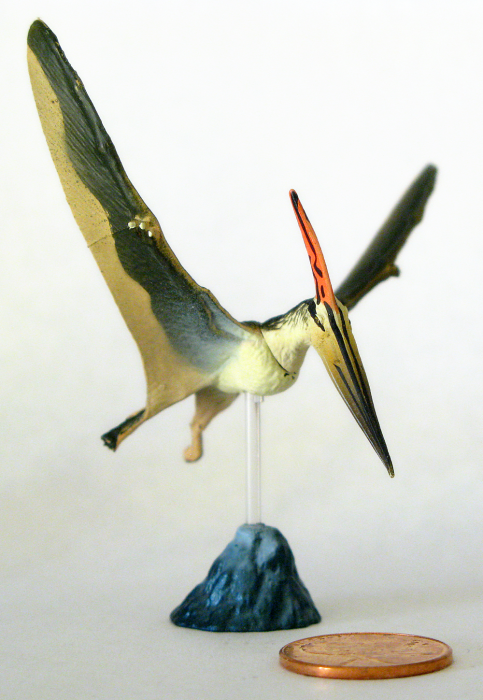
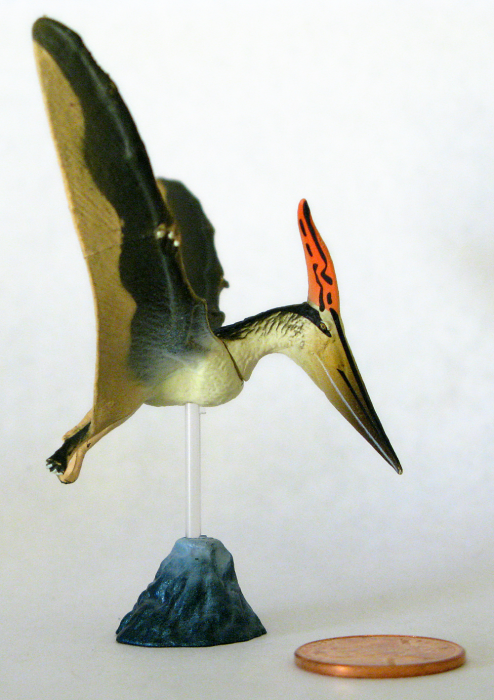
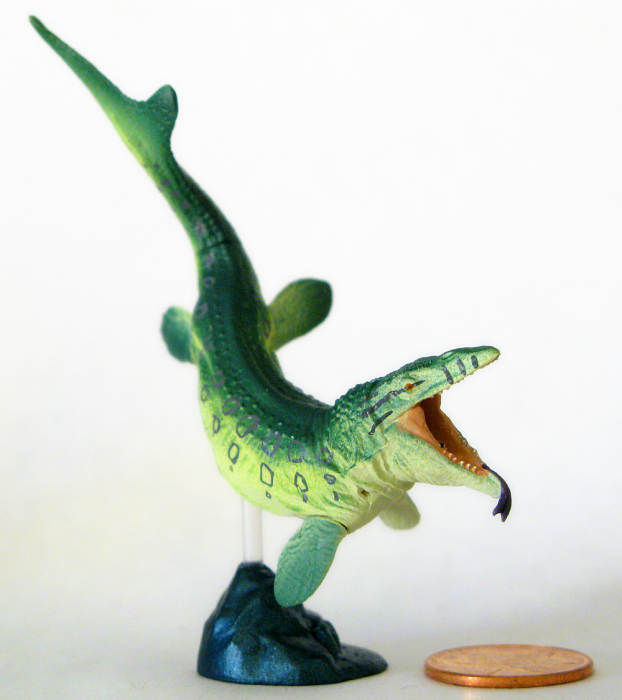

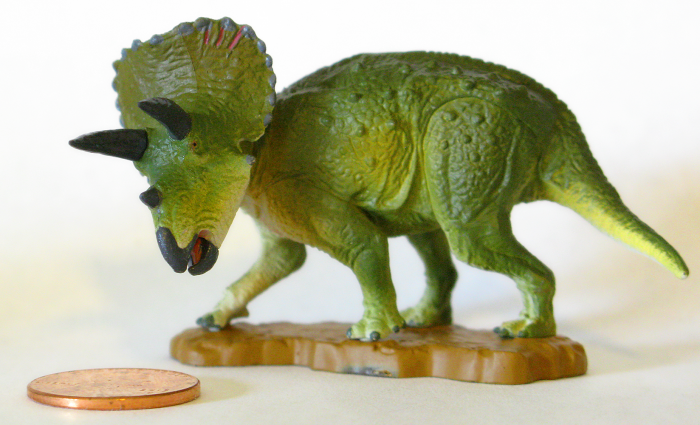
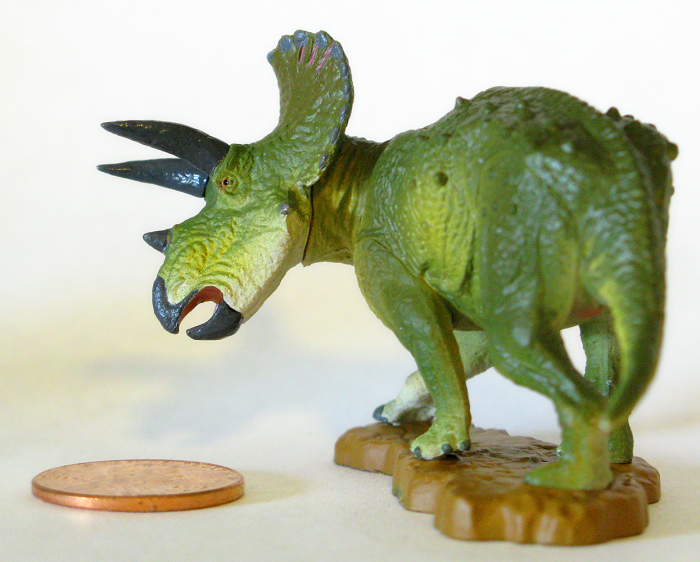


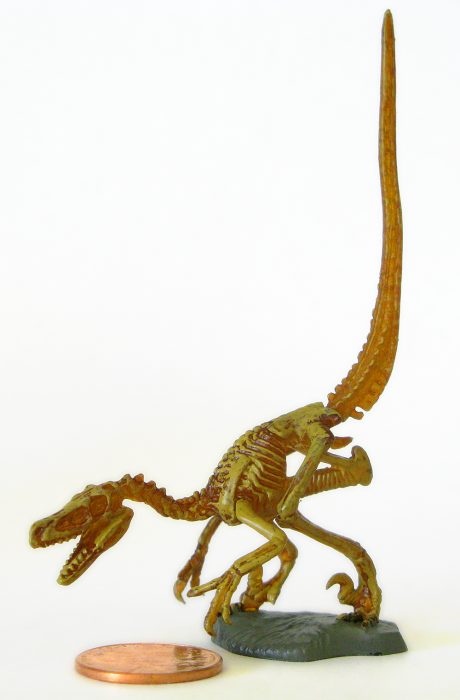
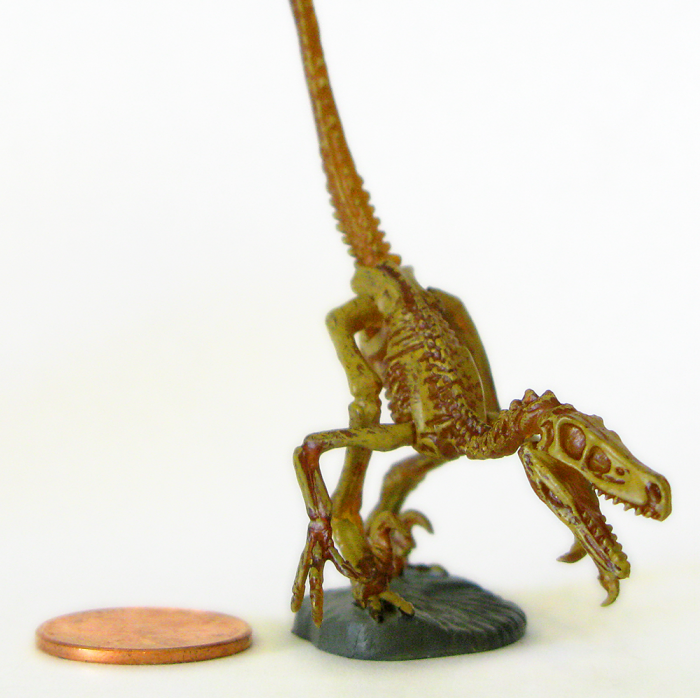
[…] face in more ways than one – it’s the same model that appeared in Kaiyodo’s 2015 Cretaceous Collection. The notable difference is in the color scheme – this Pteranodon is primarily various […]
A couple little things:the little Mosasaurus model actually does have pterygoid teeth.They aren’t painted,but they are there in the sculpt.Also,it looks like the painters painted in more nails on the Triceratops’ front feet than the sculpt actually has.I slightly repainted mine and found that only the first three digits have visible nails,while the last two do not.I guess the factory painters had no idea about this strange detail in ceratopsians,so they just painted nails in automatically on every digit.
John, thanks for confirming that detail regarding the pterygoid teeth. I was pretty sure I could see them back there, you can even almost make them out in my second photograph of the Mosasaur. I never noticed that the Triceratops’ extra toenails were another paint error, good catch!
Fine review. I love the mosasaur’s tongue!